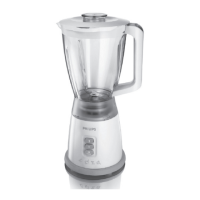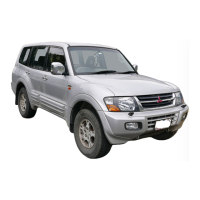Chapter 8
Clutch and driveline
8-17
21.7 Wrap the splines with tape to prevent damage to the
boot as it is removed
I
Boo! band
B 1 boot
‘D 0.1 boot
1
20-11 #dlOO 20.20’# B.1
95
Identification stamp mark
21.14
Boot and band installation details
3 Remove each steering knuckle and front hub assembly as a unit (see
Chapter 10).
4
Grasp the inner and outer joints and pull the left driveaxle out of the
differential. Be careful not to damage the differential oil seal with the dri-
veaxle inner splines as it is removed.
5 Use a jack to raise the right lower suspension arm, theniemove the
nuts and detach the shock absorber from the upper mount.
Caution: Do
not lower the jack until after the shock absorber has been reattached.
6 Remove the nuts and bolts that attach the rightdriveaxle flange to the
inner shaft
(see illustration),
then carefully pull out the driveaxle. Re-
move the circlip from the inner end of the leftdriveaxle and replace it with a
new one.
Ins talla tion
7 Attach therightdriveaxletothe innershaftflange, installthe boltsand
nuts and tighten them to the torque listed in this Chapter’s Specifications’.
8 Attach the right shock absorber to the upper mount bracket and tight-
en the nuts.
9 Install the left driveaxle in the differential and seat it by tapping on the
outer end with
a
soft-face hammer.
10 Install each steering knuckle and hub assembly and attach the ball-
joints, then adjust the driveaxle play as follows:
11 Install the snap-ring on the end of the driveaxle, but do not install the
spacer/shim.
12 Mount a dial indicator on the front hub or brake disc and position the
stem of the dial indicator against the end of the driveaxle as shown in the
accompanying illustration.
13 Move the driveaxle in and out and note the reading on the indicator.
This is the axial (end) play.
Note:
On vehicles with automaticlocking hubs,
turn the driveaxle in both directions until resistance is felt (this is the center
of the turning stroke), then check the driveaxle play with the dial indicator.
14 If the axial play is not as specified, select ashimlspacerfrom the sizes
available that will produce the correct play.
21 Front driveaxle boot replacement and Constant Velocity (CV)
joint overhaul (4WD models)
Refer to illustrations21.2, 21.4, 21.5, 21.6, 21.7, 21.14 and21.19
Note 1:
If the CVjoints exhibit signs of wear indicating need for an over-
haul (usually due to torn boots), explore all options before beginning the
job. Complete rebuilt drive&es are available on an exchange basis,
which eliminates much time and work. Whichever route you choose to
take, check on the cost and availability ofparts before disassembling the
vehicle.
Note
2: Obtain a new rubber bootkit for each joint on the driveaxle before
beginning disassembly do not disassemble the Birfield (outer) joints - if
they are worn or damaged, new driveaxles are in order.
1
Remove the boot bands by prying up the ends with ascrewdriveror by
cutting them off (new bands must be used during reassembly).
2 Use a screwdriver to remove the large circlip from the DOJ outer race
(see illustration).
3 Pull the driveaxle out the the DOJ outer race and wipe away as much
of the grease as possible.
4 Push the balls in the DOJ cage up with a screwdriver and remove
them (see
illustration).
5 Separate the cage from the inner race by turning it 30-degrees and
sliding it down the driveaxle
(see illustration).
6 Remove the snap-ring from the driveaxle with snap-ring pliers, then
pull off the inner race and slide the cage
off
the shaft
(see illustration).
7 Remove the circlip and the boots from the driveaxle. Wrap tape
around the splines on the DOJ end of the shaft so the boots are not dam-
aged by the splines
(see illustration).
8 Remove the dust covers with a large screwdriver.
9 Clean all of the components with solvent, then check the dust covers
for damage and wear. Look for water, rust, foreign material and damage in
the Birfield joints.
IO Inspect the driveaxle shafts for distortion and worn splines. Check all
circlips for distortion and cracks.
11 Check the rubber boots for damage and cracks.
Note:
Replace the
boots with new ones, even if they appear to be in good condition.
12 Checkthe cage, inner race, outer race and balls of each DOJ joint for
wear and damage.
13 Drivenewdustcoversontothejointswithasectionofpipeandaham-
mer. For Birfield joints, the pipe must be 2.71 O-inches in outside diameter
with a O.OQO-inch wall thickness. For DOJ joints, the pipe must be
2.240-inches in outside diameter with a wall thickness of 0.240-inch.
14 Wrap tape around the driveaxle splines, then install the new boots
and bands on the shaft. The Birfield and DOJ boots are different sizes and
shapes, so make sure they are correctly positioned on the shaft
(see illus-
tration).
15 Slip the DOJ cage onto the shaft, smaller diameter first. Install the cir-
clip and make sure it is seated in the shaft groove, then install the inner
race and snap-ring. Make sure the snap-ring is seated in the groove.
16 Apply the specified grease (included with the boot kit) to the DOJ in-
ner race and cage. Slip the cage into place on the inner race and turn it
30-degrees to align the ball races, then install the balls and lubricate them
with the grease.
17 Pack the DOJ outer race with 1.8 to 2.8 ounces of the specified
grease, then slide it onto the driveaxle while aligning the balls and races.
18 Pack an additional 1.8 to2.Sounces of grease into the outer race, be-
hind the inner race and cage, then install the circlip (make sure it is seated
in the groove).

